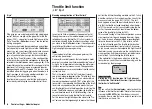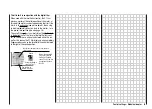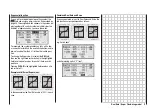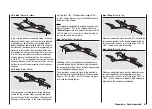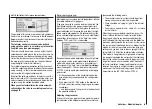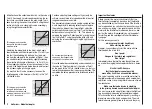
64
ricted because they are already at or close to their “up”
end-point. The remedy here is to apply “differential re-
duction”, which is explained in its own section later.
elev
fl ap
(Elevator
fl ap)
The fl aps can be used to enhance the effect of the ele-
vator in tight turns and aerobatics, and this mixer feeds
part of the elevator signal to the fl ap servos. The mixer
direction must be set so that the fl aps move down when
up-elevator is applied, and vice versa.
elev
aile
(Elevator
aileron)
This mixer allows the ailerons to reinforce the elevator
response in the same way as the previous mixer.
Combination of the “Brake
NN” mixers:
“Crow” or “Butterfl y” setting
If you have set up all three airbrake mixers for your mo-
del, it is then possible to program a special confi guration
known as the “crow” or “butterfl y” arrangement for glide
path control. In the butterfl y setting both ailerons are de-
fl ected up by a moderate amount, and both fl aps down
by the maximum possible amount. The third mixer provi-
des elevator trim to counteract any unwanted pitch trim
change and maintain the model’s airspeed at a safe le-
vel.
This inter-action between the fl aps, ailerons and eleva-
tor is used to control the glide angle on the landing ap-
proach. Optionally the butterfl y setting can also be used
without the airbrakes or spoilers; nowadays this is very
commonly used for sports and competition aircraft.
If your model features full-span (strip) ailerons which
also double as camber-changing fl aps, the two mixers
“Brake
ailerons” and “Brake
elevator” can be com-
bined for glide path control. In this case up-fl ap is ap-
plied, but the fl aps can still be controlled as ailerons.
Elevator pitch trim compensation is generally required.
If you have programmed aileron differential, the re-
sponse of the ailerons will inevitably be adversely affec-
ted by the extreme “up” defl ection of the ailerons in the
butterfl y setting, because the differential travel reduces
or entirely suppresses the down-aileron defl ection. Ho-
wever, the “up” travel of the ailerons is also greatly rest-
Wing mixers – Fixed-wing model
fl ap
elev
(Flap
elevator)
When the camber-changing fl aps are lowered, either
using »
Phase trim
« or by means of a transmitter control
assigned to input “E6”, a pitch trim change (up or down)
may occur. Alternatively it may be desirable for slight
down-elevator to be applied automatically when the
fl aps are raised slightly, in order to increase the model’s
basic airspeed. This mixer can be used to achieve both
purposes.
When the fl aps are deployed, this mixer causes the ele-
vator setting to be corrected automatically according to
the fl ap defl ection. The end-effect is therefore dependent
only upon the magnitude of the corrective value you set.
fl ap
aile
(Flap
aileron)
This mixer causes a variable proportion of the fl ap sig-
nal to be mixed in with the aileron channels 2 and 5 so
that the ailerons follow the movement of the fl aps, albeit
normally with a smaller defl ection. The net result is more
even lift distribution over the full wingspan.
Summary of Contents for MX-16S
Page 1: ...1...
Page 17: ...17...
Page 31: ...31 Fixed wing models Installation and connections...
Page 35: ...35 Program description Reserving a new memory...
Page 47: ...47 Base settings Model helicopter...
Page 83: ...83 Fail safe...
Page 89: ...89 Programming examples Fixed wing model...
Page 109: ...109 Programming examples Model helicopter...
Page 112: ...112 112...
Page 116: ...116...





